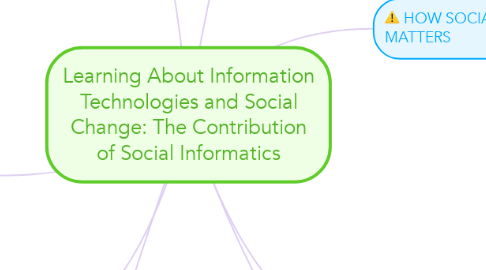Learning About Information Technologies and Social Change: The Contribution of Social Informatics
by Leslie Zendejas


1. SOME KEY IDEAS OF SOCIAL INFORMATICS
1.1. The concept of comput- erized information systems as “sociotechnical networks”3 is one such idea that helps us understand the character of new electronic information spaces
1.2. The concept of sociotechnical networks helps analysts to overcome some key limitations of determinstic impact analyses.
1.3. Information Technologies as Sociotechnical Networks
1.3.1. We found that local governments selectively adopted and developed different kinds of information systems, de- pending upon their form of internal organization.
1.3.2. The local computing package is also an example of a sociotechnical network.
1.3.3. In the highly intertwined model, the technology in use and the social world are not seen as separate
2. Sociotechnical Interaction Networks: The Vitality of Electronic Journals
2.1. The use of the Internet to support scientific communication is one of the major shifts in the practice of science in this era
2.2. These communicative practices are becoming more im- portant in many elds, although they are rarely the cen- tral communications media.
3. How Social Context Matters: Intranets in Action
3.1. One way to illustrate a contextual inquiry of information technology and social behavior is to examine case stud- ies of organizations.
3.2. Organizational informatics re- searchers found that the senior line consultants, who were partners in the rm, tended to be modest users, while the more numerous junior line consultants, called associates, were actually low users.
4. A Sociotechnical Approach to ICT Infrastructures: Public Access to Information via the Internet
4.1. There are innumerable examples of the use and value of the Internet in providing new kinds of communications to support a cornucopia of human activities in virtually
4.2. There are innumerable examples of the use and value of the Internet in providing new kinds of communications to support a cornucopia of human activities in virtually
4.3. Workable computer applications are usually supported by a strong sociotechnical infrastructure.
4.4. The policy implications of this analy- sis are that organizations that work to provide Internet access for disadvantaged groups, such as students in less well-funded schools or working-class adults in rural areas,
5. I have identified a few key ideas that come from 25 years of systematic analytical and criti- cal research about information technology and social life
5.1. These analyses differ considerably from the tradi- tional deterministic impact analyses.
5.1.1. Such analyses consider an array of relevant fac- tors, including social, cultural, organizational, and other contextual components.
5.1.2. Work processes and practices need to be studied for how they are actually carried out.
5.1.2.1. ICTs are more usefully conceived of as sociotech- nical networks than simply as tools.

